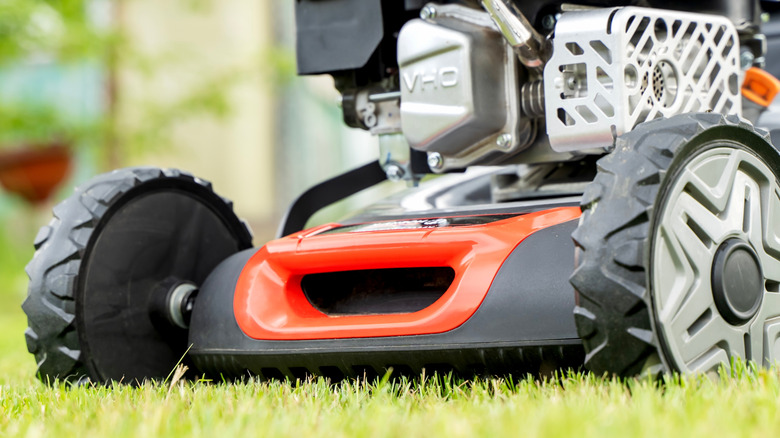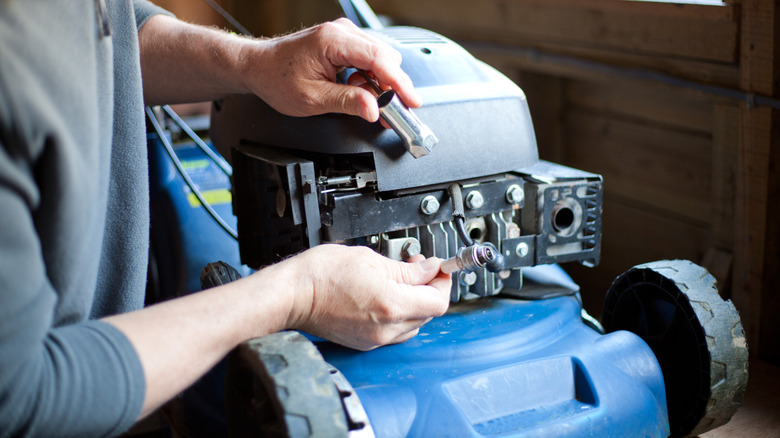Is Your Lawn Mower Turning Over But Not Starting? This Might Be The Issue.
We may receive a commission on purchases made from links.
Nearly anyone with a gas-powered lawn mower knows what it's like to break a sweat yanking at the pull cord to no avail. Even more frustrating, you can often hear the crankshaft spinning and the pistons moving, but the engine just won't start. That sound means the engine is successfully turning over, while something is preventing the fuel from igniting and starting the fuel cycle.
Neglecting to perform regular maintenance is one of the main mistakes lawn mower owners make. As a result, most of the issues that can cause a mower's engine to fail to start arise from dirty components and long periods of non-use.
The most common cause is a clog in the fuel system. That's why riding mowers with automatic ignitions can fail to start, too, since their fuel systems use the same fundamental design as those in pull-start mowers. Clogs in the fuel system typically occur in the carburetor, where airborne particles that the filter fails to catch can accumulate.
Troubleshooting a lawn mower's failure to start, therefore, begins with clearing up clogs in the fuel system. If the engine still won't start, you'll have to check for other problems. The next most common causes are issues with the ignition system and the battery. However, you should start with the fuel system, since it's also the easiest issue to tackle.
How to unclog a clog in the carburetor
Lawn mower carburetors get gunked up easily. Air filters aren't perfect, and oil residue and fuel varnish can build up over time, especially when the mower is left unused for long periods.
Unclogging an obstructed carburetor on a lawn mower is easy, and it doesn't require any professional tools. A screwdriver, a metal brush, some cleaning rags, and gloves will come in handy. As you'll see, a carburetor cleaning spray, like this one from Gumout, may also be necessary if you can't unclog it manually.
The carburetor is typically found behind or near the air filter. To access it, you may need to remove the filter, placing it aside for later. The most identifiable part of the carburetor is its fuel solenoid, which also happens to be the common culprit for carburetor clogs. The fuel solenoid is a small metal cylinder that sticks out of the bottom or the side of the carburetor.
The fuel solenoid contains a floating valve that can get stuck, so gently tap it a few times with a screwdriver to try to loosen the valve. Use this opportunity to clean the filter, either with a vacuum or an air compressor, and then reattach it. Then, try starting the engine and adjusting the choke to get the air flowing properly. (It's also a good idea to learn how the choke valve works in the first place.)
If your engine still won't start, you'll have to use a carburetor cleaner. Remove the filter again and locate the air intake. Spray one or two short spritzes directly in. Then, let the solution soak a bit to dissolve any gunk, and try starting the engine. If it doesn't start after that, there's a good chance the carburetor isn't the culprit.
Other reasons your lawn mower might not start
While a clog in the carburetor is usually the reason a mower will turn over but not start, it's not the only one. Another possible problem is with the ignition system.
Both riding mowers and pull-start mowers have spark plugs, which can get dirty or damaged and fail. Luckily, they're easy to inspect, clean, and replace. In a pull-start mower, search around for the spark plug near the hole where the pull cord feeds through. If you can't find it, try searching the web for your specific model's parts diagram. In a riding mower, lift the hood and look for the tell-tale spark plug wires.
Remove the spark plug and inspect it for debris or corrosion. If it's dirty, clean it with a brush and solvent like isopropyl alcohol. If it's significantly damaged or burnt beyond repair, you'll have to replace it with a new one.
Another problem could be a faulty ignition coil. It's a simple component that's attached directly to the spark plug. You can check your owner's manual to find it. Once you identify it, inspect it for damage. If it's broken in any way, you'll have to replace it.
Riding mowers have automatic electric ignition systems. They're easier to use than yanking on a pull cord, but they also come with an extra potential point of failure: the battery. Batteries can lose charge when the mower is left unused for long periods of time, such as during winter months. They can also die from extreme changes in temperature or corrosion. In any case, you should test your battery to see if it's dead. Try flicking on the headlights and other electronics, or use a battery tester. If it is dead, recharge it using a battery charger.


